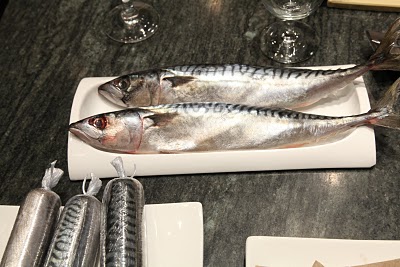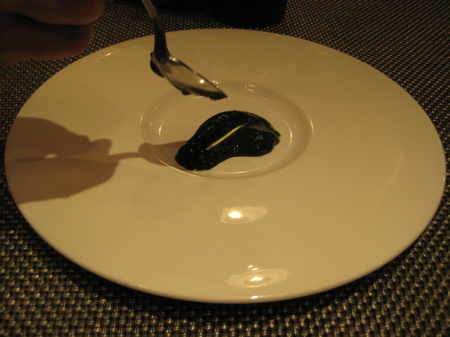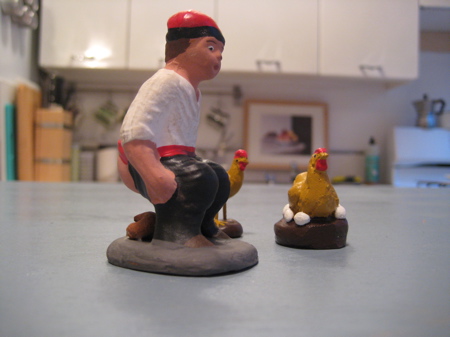teresa's blog
October 26, 2010 Lluís Plà, age 87, is the host of La Carbonera de Forallac, part country barbecue, part Burning Man Project, a wonderfully odd happening that runs 24/7 for nearly three weeks every October. A sign on the road connecting La Bisbal to Palafrugell, hardworking inland towns near Catalonia's Costa Brava, points the way to the celebration. My friend Assumpta and I showed up mid-morning last Thursday during a lull in the action that allowed Sr. Plà to tell us about what appeared to be a woolly mammoth, alive and snoring steamily at his feet––the centerpiece of La Carbonera.
Lluís Plà, age 87, is the host of La Carbonera de Forallac, part country barbecue, part Burning Man Project, a wonderfully odd happening that runs 24/7 for nearly three weeks every October. A sign on the road connecting La Bisbal to Palafrugell, hardworking inland towns near Catalonia's Costa Brava, points the way to the celebration. My friend Assumpta and I showed up mid-morning last Thursday during a lull in the action that allowed Sr. Plà to tell us about what appeared to be a woolly mammoth, alive and snoring steamily at his feet––the centerpiece of La Carbonera.Cows are important on Minorca and have been going way back. Archaeologists have found evidence of cheesemaking on this tiny island dating from 2000BC, and historians say Minorcan cheese crisscrossed the Mediterranean with Moorish and Pisan traders in the Middle Ages. Eaters may be interested to know that you can now buy the good stuff -- that is, artisanally-made raw milk Maó de Minorca D.O.P. (complete with the Spanish denominación de origen protegida "Mahón de Menorca") -- in the U.S.
 Still in New York, sniffing around the Greenmarket for the first signs of fruit and smelling nothing but ramps. Of course, if I were in Catalonia right now it would be a whole different story: I'd be bathing in rose petals and eating fruits vermells, the red fruits of early summer. I've been working on a dessert as pink and tart as that fantasy. Here it is: a fresh strawberry and raspberry soup
Still in New York, sniffing around the Greenmarket for the first signs of fruit and smelling nothing but ramps. Of course, if I were in Catalonia right now it would be a whole different story: I'd be bathing in rose petals and eating fruits vermells, the red fruits of early summer. I've been working on a dessert as pink and tart as that fantasy. Here it is: a fresh strawberry and raspberry soup  We never made chocolate desserts when I was in cooking school in Barcelona twenty years ago. Don't get me wrong. The Catalans love the stuff, and so do the Spaniards: bread and chocolate have probably been the entire peninsula's favorite after-school snack since around 1500, when Cortez came back to Spain with a freighter-sized stash he got from the Aztecs. But my teachers frowned on chocolate as too heavy to take center stage in an after-dinner role.
We never made chocolate desserts when I was in cooking school in Barcelona twenty years ago. Don't get me wrong. The Catalans love the stuff, and so do the Spaniards: bread and chocolate have probably been the entire peninsula's favorite after-school snack since around 1500, when Cortez came back to Spain with a freighter-sized stash he got from the Aztecs. But my teachers frowned on chocolate as too heavy to take center stage in an after-dinner role.

"I always wanted to eat plankton," said Angel León, beginning the story of one of his culinary affairs. He seemed too sweet to be a chef, especially one of Spain's most inventive ones. "When I was young," he went on, "I remember they told us all about how whales feast on it." He looked hopefully across the room full of cooks and students who gathered to hear him last Thursday at the French Culinary Institute in New York City. "I mean, it always seemed to me it would be kind of like eating life itself — primordial."

Some of you (especially readers around age two) may have felt drawn to the little guy peeking out from behind the pile of mantecados I wrote about last week. He's my favorite caganer, a traditional rendition of the Catalan shitting man. He takes his place in all Catalan nativity scenes (even the ones in churches) to remind you of your humanity.




